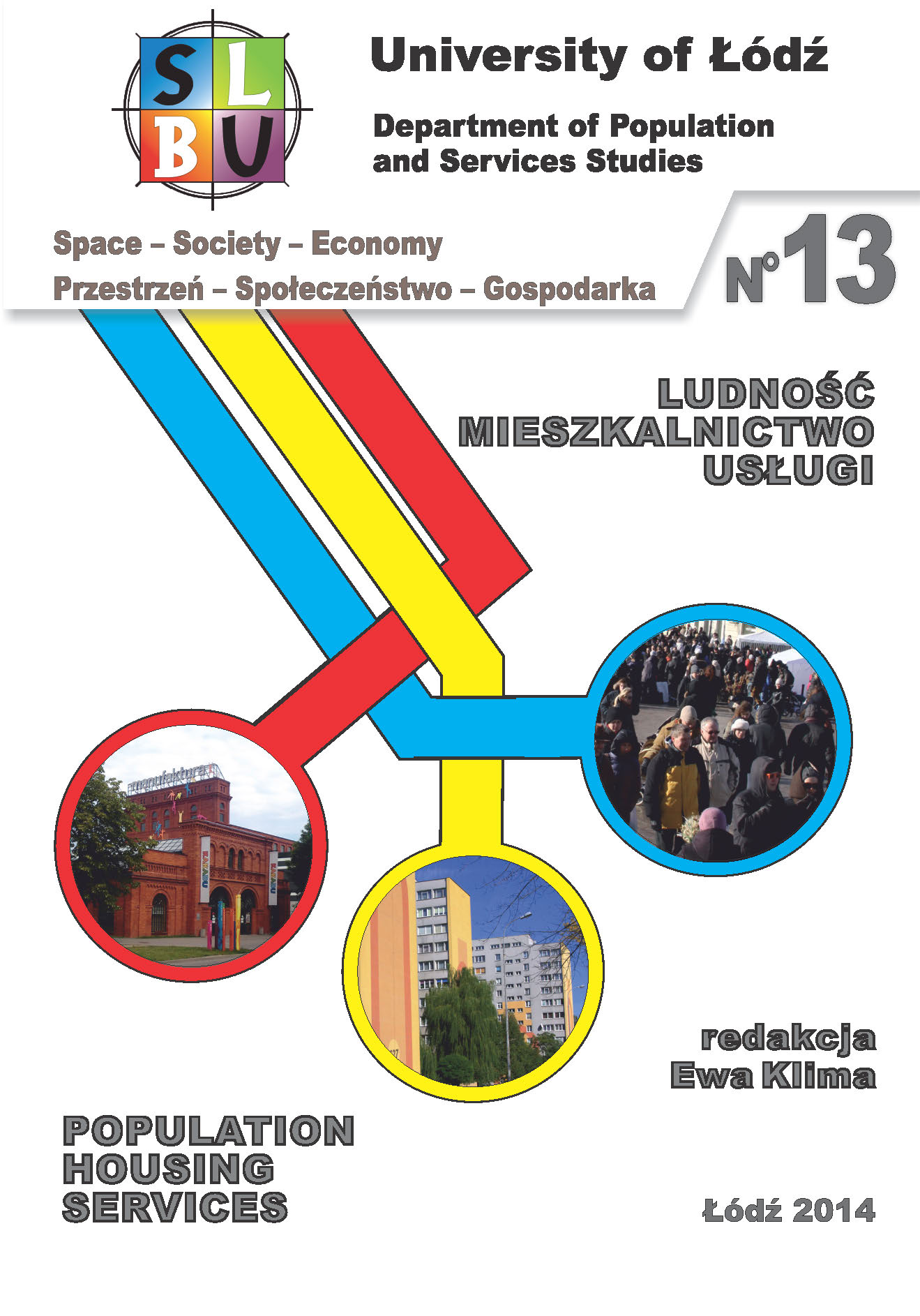Shopping malls as a hybrid space
DOI:
https://doi.org/10.18778/1733-3180.13.15Keywords:
shopping malls, public space, hybrid spaceAbstract
Public spaces understood as areas which can be accessed freely and which offer freedom of behaviour and speech have always been an important element of any city or town. Shopping malls enter urban landscape often becoming city landmarks, thus, competing with traditional public spaces. In terms of qualitative criteria, they function well as public spaces but at the same time those areas include numerous limitations which prevent them from being real public spaces. Within the public-private dimension, they constitute transitional hybrid spaces with the features of a proper public space. Shopping malls focus important social functions, thus, replacing or “relieving” traditional public spaces in city centres. One must remember, though, that their public character is severely limited (time, offer, staff, behaviour, social, or political limitations) which is why it is difficult to consider shopping malls as classic public spaces.
Because of the role of those modern shopping and service spaces it is necessary to try and place shopping malls in relation to urban public spaces. The goal should be to define certain relations between traditional public spaces and hybrid spaces (including the areas of shopping malls) in order for them to benefit the inhabitants and to help improve the functioning of cities or towns. The fact that shopping malls have, to a large extent, substituted public spaces, that they are visited often, that they are the place where people spend a considerable amount of their free time and that they are considered by the population as important locations in people's lives seem particularly important.
Downloads
References
Abbasalipour S., Bruce J., 2011, Blurring the boundaries. The interface of shopping centers and surrounding urban public space, http://soac.fbe.unsw.edu.au/2011/papers/SOAC2011_0115_final.pdf.
Google Scholar
Bauman Z., 2000, Globalizacja, Państwowy Instytut Wydawniczy, Warszawa.
Google Scholar
Celińska-Janowicz D., 2011, Centra handlowe wobec miejskiej przestrzeni publicznej – nie tylko imitacja [w:] Człowiek w przestrzeni publicznej miasta, „XXIV Konwersatorium Wiedzy o Mieście”, Wydawnictwo UŁ, Łódź, s. 149‒156.
Google Scholar
Chmielewski J.M., 2004, Rola miejskich przestrzeni publicznych, „Urbanista” 4, Warszawa.
Google Scholar
Downtown Seattle. Public spaces and public life, 2009, International Sustainability Institute Seattle; consultant Gehl Architects, Copenhagen.
Google Scholar
Dzieciuchowicz J., 2012, Wielkie centrum handlowe w przestrzeni miejskiej i podmiejskiej. Manufaktura w Łodzi i Ptak w Rzgowie, Wydawnictwo UŁ, Łódź.
Google Scholar
DOI: https://doi.org/10.18778/7525-737-3
Gehl J., 2004, Lively, attractive and safe cities ‒ but now?, http://www.botsfor.no/publikasjoner/Litteratur/New%20Urbanism/Lively,%20attractive%20and%20safe%20cities%20but%20how%20by%20Jan%20Gehl.pdf.
Google Scholar
Ghirardo D., 1999, Architektura po modernizmie. Wydawnictwo VIA, Toruń.
Google Scholar
Hopkins J.S.P., 1991, West Edmonton Mall as a Centre for social interactions, „The Canadian Geographer” 35(3), s. 268‒279.
Google Scholar
DOI: https://doi.org/10.1111/j.1541-0064.1991.tb01101.x
Janiszewska A., Klima E., Rochmińska A., 2011, Centra handlowe w Łodzi – zawłaszczona, przestrzeń publiczna? [w:] Jażdżewska I. (red.), Człowiek w przestrzeni publicznej miasta, „XXIV Konwersatorium Wiedzy o Mieście”, Wydawnictwo UŁ, Łódź, s. 157‒165.
Google Scholar
Karta Przestrzeni Publicznej, 2009, www.tup.org.pl (dostęp 12.06.2011).
Google Scholar
Kochanowska D., 2010, Przestrzeń publiczna ‒ kluczowy element miasta współczesnego ‒ zintegrowana czy podzielona? [w:] Lorens P., Martyniuk-Pęczek J. (red.), Problemy kształtowania przestrzeni publicznych, Miasto, Metropolia, Region, Wydawnictwo Urbanista, Gdańsk, s. 21‒35.
Google Scholar
Kohn M., 2004, Brave new neighborhoods. The privatization of public space, Routledge, New York & London.
Google Scholar
DOI: https://doi.org/10.4324/9780203495117
Krause K., 2010, Przestrzeń publiczna jako przestrzeń handlu [w:] Lorens P., Martyniuk-Pęczek J. (red.), Problemy kształtowania przestrzeni publicznych, Miasto, Metropolia, Region, Wydawnictwo Urbanista, Gdańsk, s. 100‒106.
Google Scholar
Kwiatkowski K., 2010, Przestrzeń publiczna i jej uzurpatorskie zawłaszczanie, „Czasopismo Techniczne” 2-A, Wydawnictwo Politechniki Krakowskiej.
Google Scholar
Ledwoń S., 2009, Przekształcenia obszarów śródmiejskich z udziałem funkcji handlowej [w:] Lorens P., Martyniuk-Pęczek J. (red.), Wybrane zagadnienia z rewitalizacji miast, Wydawnictwo Urbanista, Gdańsk, s. 36‒58.
Google Scholar
Lorens P., 2010, Definiowanie współczesnej przestrzeni publicznej [w:] Lorens P., Martyniuk-Pęczek J. (red.), Problemy kształtowania przestrzeni publicznych, Miasto, Metropolia, Region, Wydawnictwo Urbanista, Gdańsk, s. 6‒20.
Google Scholar
Lorens P., 2010a, Główne typy i rodzaje współczesnych przestrzeni publicznych [w:] Lorens P., Martyniuk-Pęczek J. (red.), Problemy kształtowania przestrzeni publicznych, Miasto, Metropolia, Region, Wydawnictwo Urbanista, Gdańsk, s. 62‒71.
Google Scholar
Makowski G., 2003, Świątynia konsumpcji. Geneza i społeczne znaczenie centrum handlowego, Wydawnictwo Trio, Warszawa.
Google Scholar
Mironowicz I., 2010, Współczesne dylematy przestrzeni publicznej [w:] Lorens P., Martyniuk-Pęczek J. (red.), Problemy kształtowania przestrzeni publicznych, Miasto, Metropolia, Region, Wydawnictwo Urbanista, Gdańsk, s. 36‒49.
Google Scholar
Mordwa S., 2012, Poczucie bezpieczeństwa w centrach handlowych. Przykład badań opinii klientów Galerii Łódzkiej i Manufaktury w Łodzi, „Acta Universitatis Lodziensis. Folia Geographica Socio-Oeconomica” 12, s. 163‒187.
Google Scholar
Nissen S., 2008, Urban transformation from public and private space to space of hybrid character, „Czech Sociological Review” 44(6), s. 1129‒1149.
Google Scholar
DOI: https://doi.org/10.13060/00380288.2008.44.6.04
Ossowicz T., 2009, Przestrzenie publiczne w sferze dyskusji, Konferencja naukowa na temat przestrzeni publicznej, Poznań, 27‒29.05.2009 r.
Google Scholar
Pancewicz Ł., 2010, Prywatyzacja przestrzeni publicznych [w:] Lorens P., Martyniuk-Pęczek J. (red.), Problemy kształtowania przestrzeni publicznych, Miasto, Metropolia, Region, Wydawnictwo Urbanista, Gdańsk, s. 80‒91.
Google Scholar
PRCH, http://prch.org.pl/PL/BazaWiedzy/Definicje/Default.aspx.
Google Scholar
PRCH, http://prch.org.pl/PL/StronaGlowna/Default.aspx.
Google Scholar
Racoń-Leja K., 2007, Przestrzeń publiczna zagrożona, „Czasopismo Techniczne”, 2-A, Wydawnictwo Politechniki Krakowskiej.
Google Scholar
Rochmińska A., 2011, Zakupy a czas wolny Łodzian, „Acta Univesritatis Lodziensis. Folia Oeconomica” 11, Wydawnictwo UŁ, Łódź, s. 207‒217.
Google Scholar
Rochmińska A., 2013, Atrakcyjność łódzkich centrów handlowych oraz zachowania nabywcze i przestrzenne ich klientów, Wydawnictwo UŁ, Łódź.
Google Scholar
DOI: https://doi.org/10.18778/7525-865-3
Songülen N., 2012, Space organization in urban block: interfaces among public, common and private spaces based on Conzen method in Bahcelievler, http://etd.lib.metu.edu.tr/upload/12614461/index.pdf.
Google Scholar
Tyndall A., 2010, It`s a public, I reckon: Publicness and a suburban shopping mall in Sydney`s Southwest, „Geographical Research” 48(2), s. 123‒136.
Google Scholar
DOI: https://doi.org/10.1111/j.1745-5871.2009.00621.x
Ustawa o planowaniu i zagospodarowaniu przestrzennym z 2003 r., Dz.U. z 2003 r., nr 80, poz. 717 ze zm.
Google Scholar
Downloads
Published
How to Cite
Issue
Section
License

This work is licensed under a Creative Commons Attribution-NonCommercial-NoDerivatives 4.0 International License.









